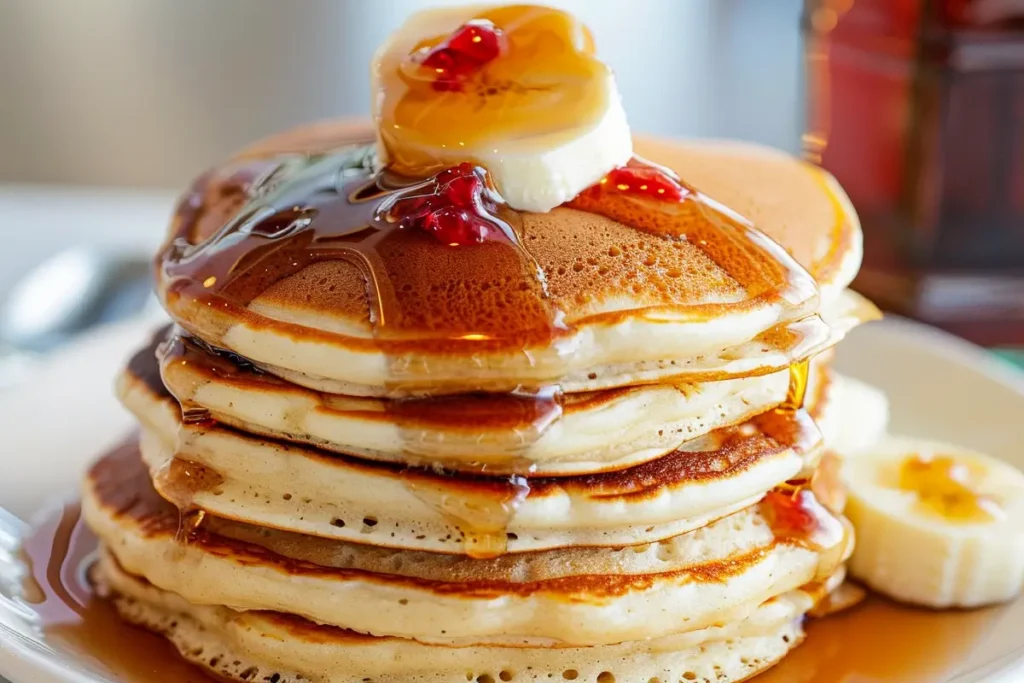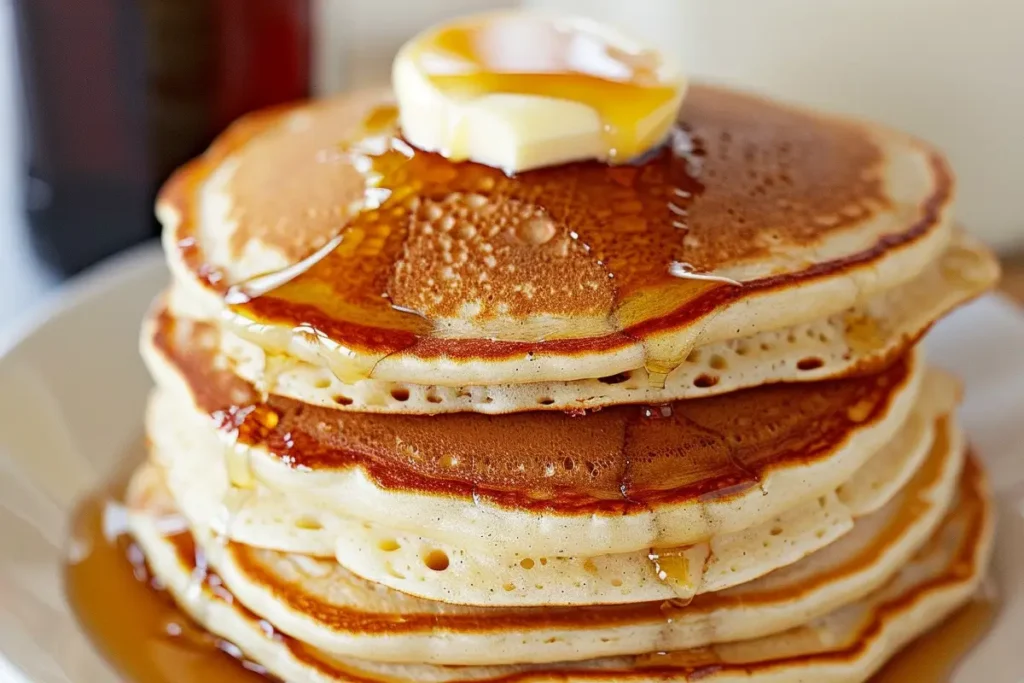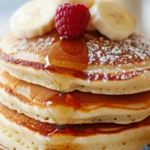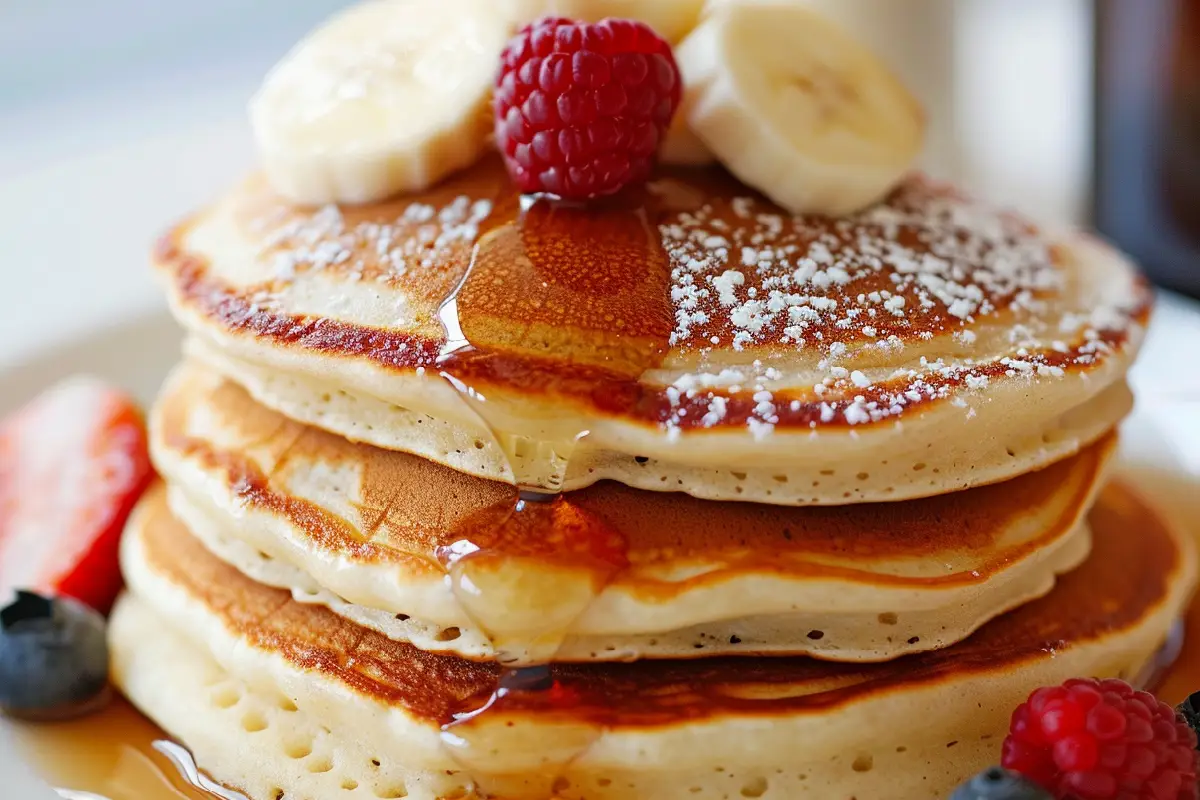Table of Contents: Why Are Restaurant Pancakes So Fluffy?
Introduction: Why Are Restaurant Pancakes So Fluffy?
There’s something magical about biting into a stack of fluffy, melt-in-your-mouth restaurant pancakes. You know the kind—golden on the outside, soft as a cloud on the inside, and so light they practically float off the plate. But why do diner pancakes always taste better than the ones we make at home?
The secret isn’t some mysterious ingredient or a fancy chef’s technique—it’s all in three simple tricks that anyone can master. Whether you love classic buttermilk pancakes or prefer a twist like our Best Blueberry Pancakes, these pro tips will take your breakfast game to the next level.
Pancakes are the ultimate comfort food—quick, easy, and loved by kids and adults alike. But if yours turn out flat, dense, or rubbery, don’t worry! Today, we’re revealing the three foolproof secrets that restaurants use to make their pancakes irresistibly fluffy. Get ready to flip the best homemade pancakes of your life!
What Are Restaurant-Style Fluffy Pancakes?
Ever wondered why diner pancakes taste like little pillows of joy? Why are restaurant pancakes so fluffy? Is it sorcery? A secret pact with the breakfast gods? Nope—it’s just science and smart cooking tricks!
These pancakes aren’t your average flapjacks. They’re taller, lighter, and more tender than the ones most of us make at home. And while some say “the way to a man’s heart is through his stomach,” we say the way to everyone’s heart is through a stack of perfect pancakes.
So, what’s the deal? Do restaurants use a special flour? A hidden ingredient? Or do they just whisper sweet nothings to the batter? (Spoiler: It’s none of those.) Keep reading to discover the three easy tricks that will make your pancakes as fluffy as the ones from your favorite brunch spot!
Why You’ll Love This Recipe
- Light & Fluffy Perfection – No more dense, chewy pancakes! These turn out tall, airy, and tender, just like the ones from your favorite diner.
- Cheaper Than Eating Out – Why spend $15 on brunch when you can make even better pancakes at home for a fraction of the cost?
- Endless Customization – Add chocolate chips, blueberries, or cinnamon to make them your own. (Pro tip: Try them with our [Homemade Maple Syrup](insert link) for extra deliciousness!)
Once you try these, you’ll never go back to boxed mix or sad, flat pancakes again. Ready to learn the secrets? Let’s get flipping!
How to Make Fluffy Restaurant-Style Pancakes

Quick Overview
✔ Prep Time: 10 mins
✔ Cook Time: 15 mins
✔ Total Time: 25 mins
✔ Servings: 8-10 pancakes
✔ Difficulty: Easy
These pancakes are quick, foolproof, and guaranteed fluffy every time. The secret? Three simple tricks that take your batter from meh to magnificent!
Key Ingredients
- 1 ½ cups all-purpose flour (spooned & leveled)
- 3 ½ tsp baking powder (the #1 fluff-maker!)
- 1 tbsp sugar (for a hint of sweetness)
- ½ tsp salt (balances the flavors)
- 1 ¼ cups milk (whole milk works best)
- 1 egg (room temperature)
- 3 tbsp melted butter (plus extra for cooking)
- 1 tsp vanilla extract (optional but delicious)
Step-by-Step Instructions
1. Don’t Overmix the Batter
- Whisk dry ingredients (flour, baking powder, sugar, salt) in one bowl.
- In another, mix wet ingredients (milk, egg, melted butter, vanilla).
- Gently combine wet and dry—lumps are okay! Overmixing = tough pancakes.
2. Let the Batter Rest (The Secret to Fluffiness!)
- Let it sit for 5-10 minutes before cooking. This allows the baking powder to activate, creating air pockets for maximum fluff.
3. Cook on Medium-Low Heat
- Use a non-stick pan or griddle on medium-low (not high!) heat.
- Pour ¼ cup batter per pancake. When bubbles form on top (after ~2 mins), flip and cook another 1-2 mins.
What to Serve With Fluffy Pancakes
- 🥓 Crispy bacon or sausage (sweet & salty = perfection)
- 🍓 Fresh berries & whipped cream (for a fancy touch)
- 🍯 Warm maple syrup or honey (a must!)
- ☕ Cold brew coffee or orange juice (the ultimate brunch duo)
Top Tips for Perfect Pancakes
✔ Use fresh baking powder (old = flat pancakes).
✔ Flip only once (too much flipping = deflated pancakes).
✔ Keep cooked pancakes warm in a 200°F oven while finishing the batch.
Storing & Reheating Tips
- Fridge: Store in an airtight container for up to 3 days.
- Freezer: Layer between parchment paper & freeze for up to 2 months.
- Reheat: Warm in a toaster, microwave (10-15 secs), or oven (5 mins at 350°F).
FAQs: Why Are Restaurant Pancakes So Fluffy?

Got questions? We’ve got answers! Here are the most common questions about making ultra-fluffy restaurant-style pancakes at home.
1. Why are my homemade pancakes not as fluffy as restaurant pancakes?
The #1 reason? Overmixing the batter! Restaurants gently mix their batter (leaving lumps) and let it rest before cooking. Overmixing develops gluten, making pancakes dense instead of light.
2. Can I make these pancakes without baking powder?
Baking powder is key for fluffiness, but you can substitute with 1 tsp baking soda + 1 tbsp vinegar or lemon juice (mix into wet ingredients). However, the texture won’t be quite as airy.
3. What’s the best pan for fluffy pancakes?
A non-stick griddle or cast-iron skillet works best. Avoid stainless steel—pancakes may stick. Pro tip: Preheat the pan properly (medium-low heat) for even cooking.
4. Why do restaurant pancakes taste richer?
Many diners use melted butter in the batter (not oil) and cook on a well-seasoned griddle. Some even add a splash of buttermilk or vanilla for extra flavor.
5. Can I make the batter ahead of time?
Yes! Mix dry and wet ingredients separately, then combine right before cooking. Letting batter sit too long (more than 30 mins) can make pancakes less fluffy.
6. How do I keep pancakes warm without drying them out?
Place cooked pancakes on a baking sheet in a 200°F oven (single layer, uncovered). Avoid stacking—they’ll steam and get soggy!
7. Can I freeze fluffy pancakes?
Absolutely! Let them cool, then freeze in a single layer before transferring to a bag. Reheat in a toaster for a crispy edge or microwave for 20-30 seconds.
Conclusion: Why Are Restaurant Pancakes So Fluffy?
Now you know why restaurant pancakes are so fluffy—and how to make them even better at home! With these three simple tricks, you’ll never settle for flat, rubbery pancakes again.
Print
The Best Fluffy Pancakes
- Total Time: 25 mins
- Yield: 8–10 pancakes 1x
- Diet: Vegetarian
Description
“Discover the secret to light, fluffy restaurant-style pancakes at home! These golden, melt-in-your-mouth pancakes are tall, tender, and foolproof—thanks to 3 simple tricks. Perfect for weekend brunch or a cozy breakfast!”
Ingredients
- 1 ½ cups all-purpose flour (spooned & leveled)
- 3 ½ tsp baking powder
- 1 tbsp sugar
- ½ tsp salt
- 1 ¼ cups whole milk (or buttermilk for extra fluffiness)
- 1 large egg (room temperature)
- 3 tbsp melted butter (plus extra for cooking)
- 1 tsp vanilla extract (optional)
Instructions
- Mix dry ingredients: Whisk flour, baking powder, sugar, and salt in a large bowl.
- Combine wet ingredients: In another bowl, mix milk, egg, melted butter, and vanilla.
- Gently fold together: Pour wet ingredients into dry and stir until just combined (lumps are okay!).
- Rest the batter: Let sit for 5–10 minutes (key for fluffiness!).
- Cook: Heat a non-stick pan over medium-low. Pour ¼ cup batter per pancake. Flip when bubbles form (~2 minutes). Cook another 1–2 minutes.
- Serve warm with maple syrup and butter!
Notes
- Don’t overmix—lumpy batter = fluffy pancakes.
- No baking powder? Substitute 1 tsp baking soda + 1 tbsp lemon juice.
- Freezer-friendly: Layer cooled pancakes between parchment paper and freeze for up to 2 months.
- Prep Time: 10 mins
- Cook Time: 15 mins
- Category: Breakfast
- Method: Stovetop
- Cuisine: American
Nutrition
- Serving Size: 1 pancake
- Calories: 150 kcal
- Sugar: 3g
- Sodium: 220mg
- Fat: 6g
- Saturated Fat: 3.5g
- Unsaturated Fat: 2g
- Trans Fat: 0g
- Carbohydrates: 20g
- Fiber: 1g
- Protein: 4g
- Cholesterol: 35mg
Keywords: fluffy pancakes, diner-style pancakes, easy pancake recipe, best homemade pancakes, buttermilk pancakes

